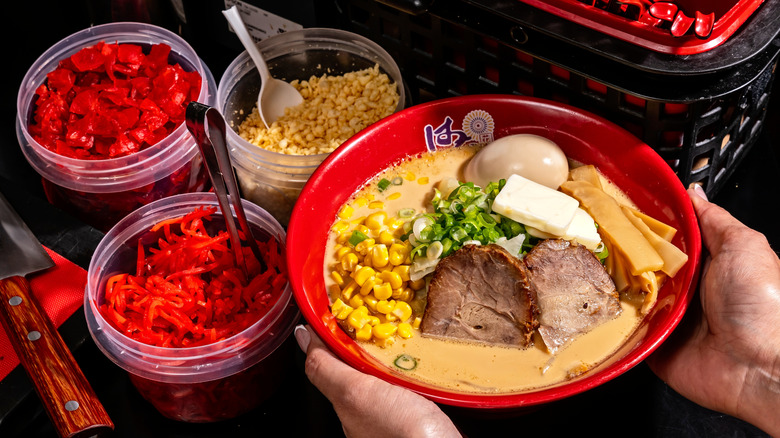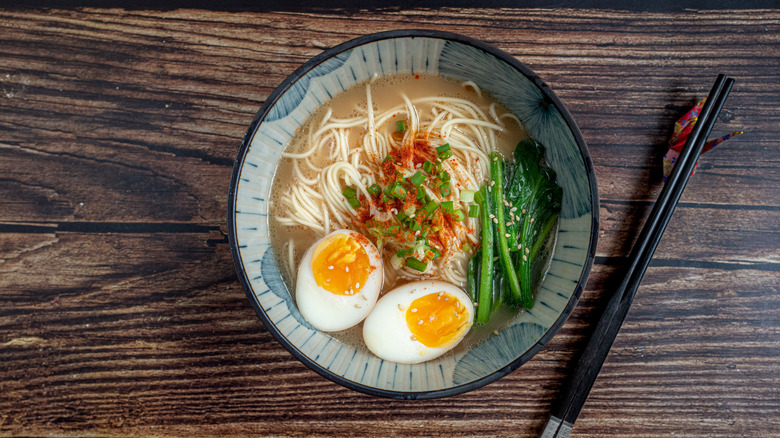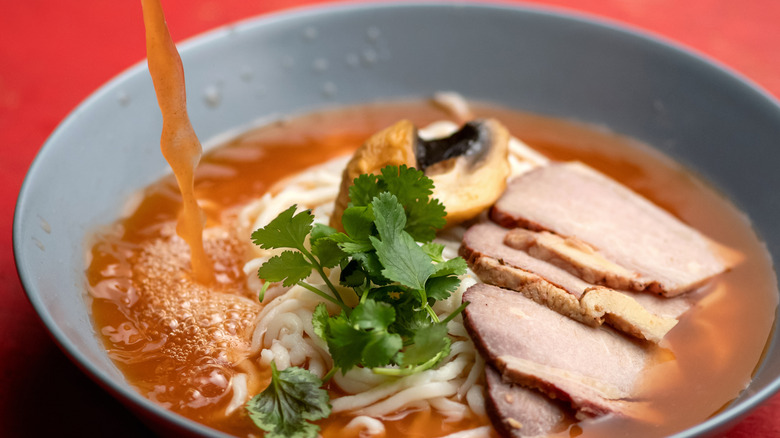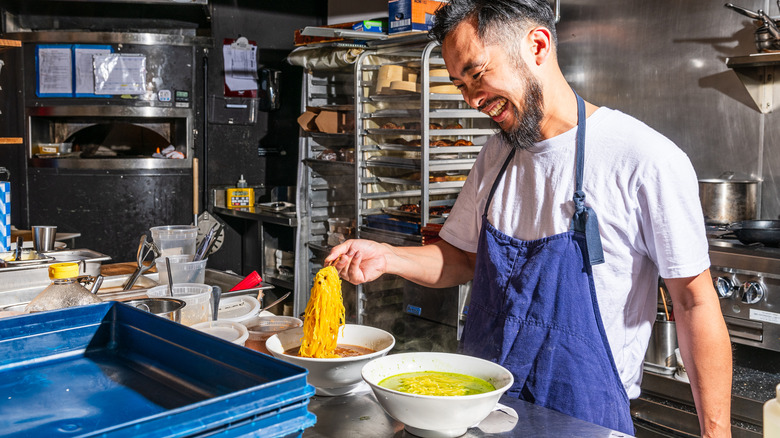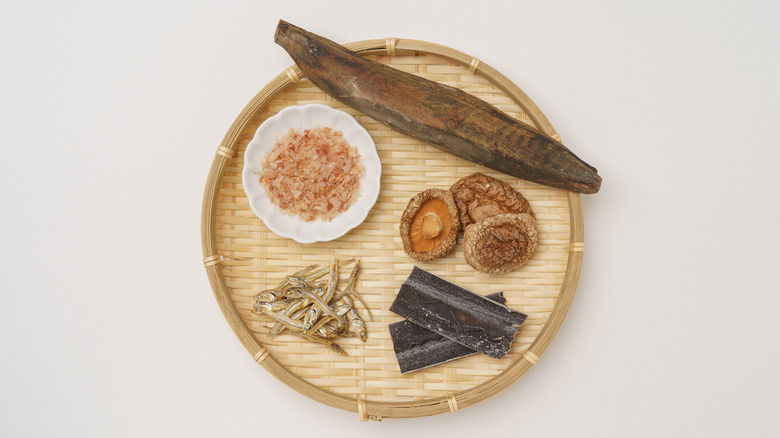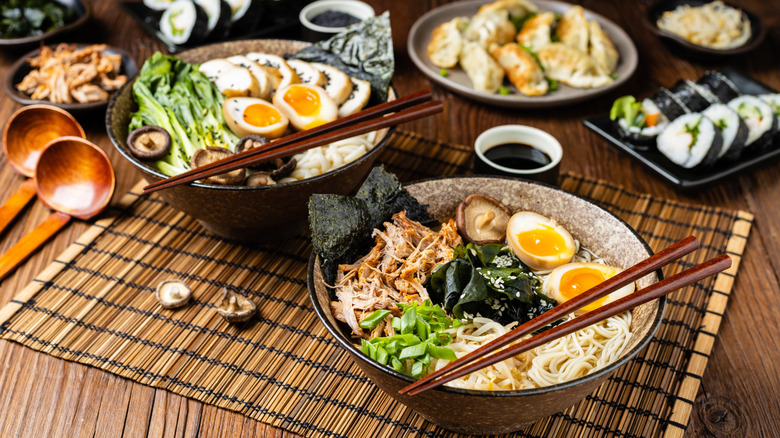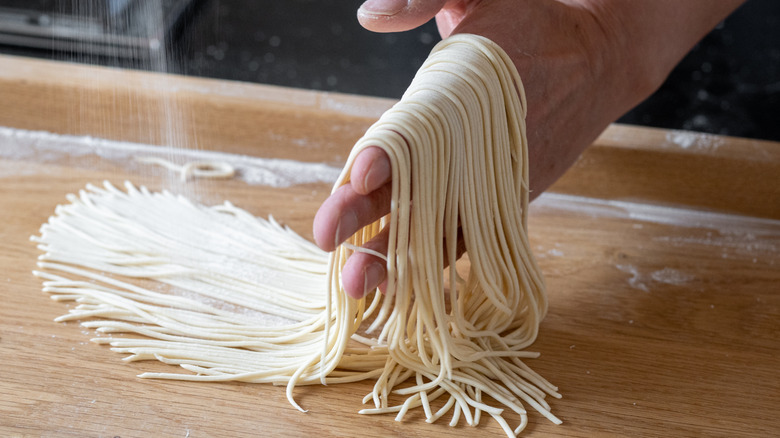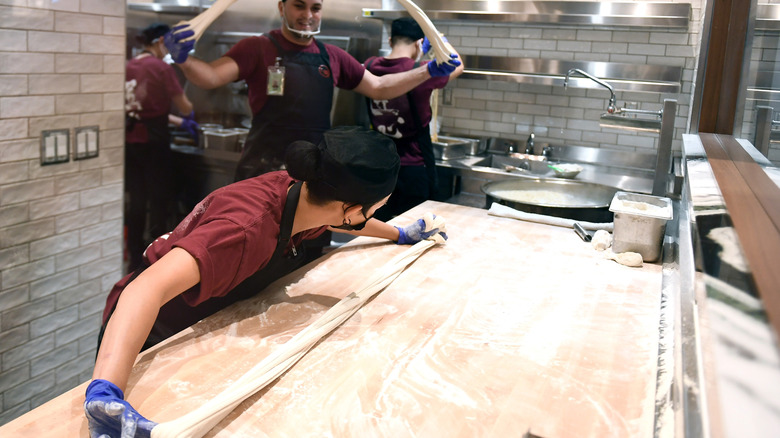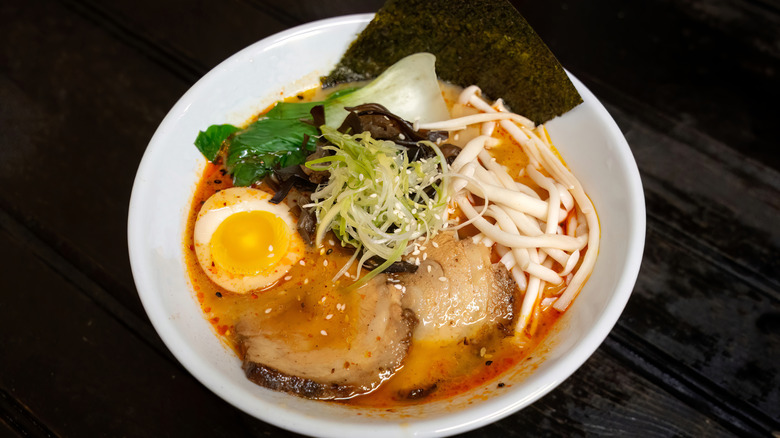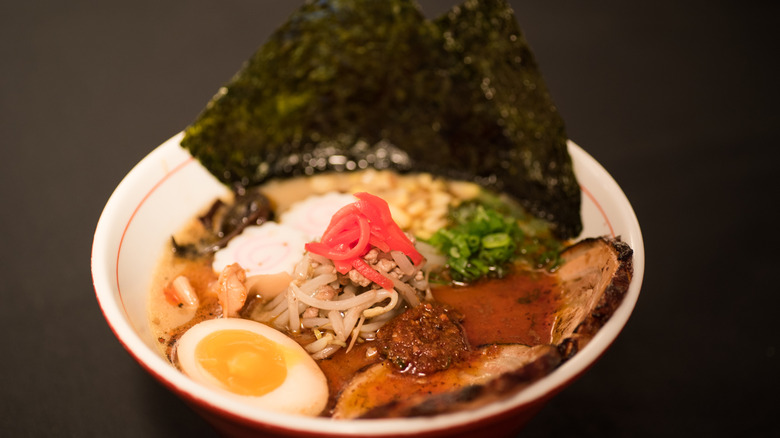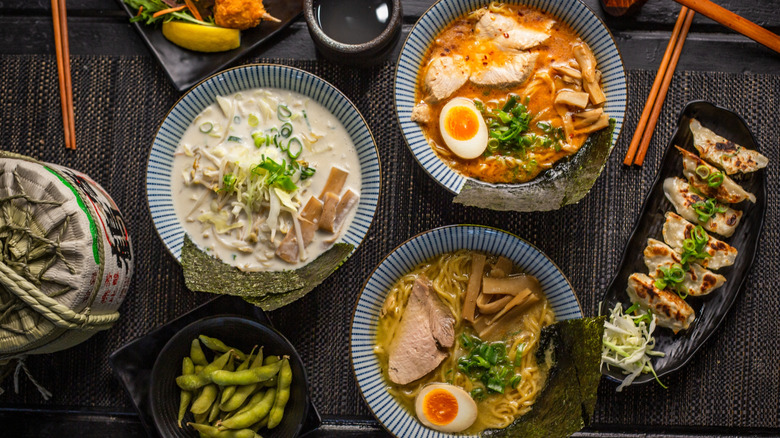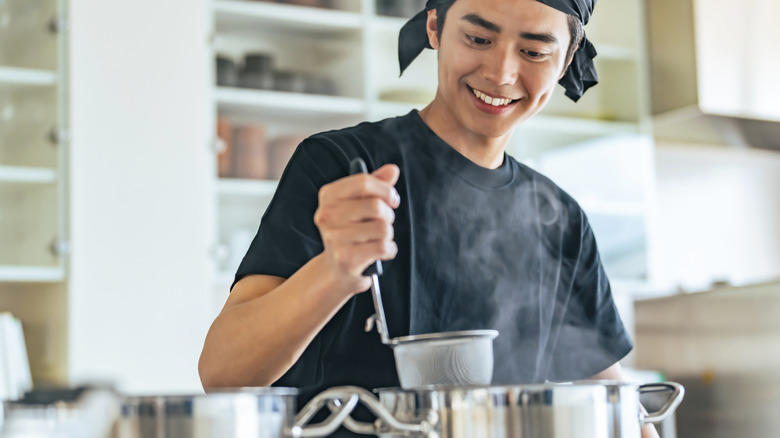Why Ramen Always Tastes Better At A Restaurant
There was a time when the word ramen was synonymous with instant noodles. Now, don't get us wrong, we love instant noodles, but there's a big difference between that and real ramen. We're not even going to try to compare instant ramen to the restaurant quality stuff, but if you've ever tried to make a good bowl of ramen at home, you might be wondering why it never compares to the restaurant meal.
Maybe your noodles are soggy or mushy instead of springy. Or perhaps the broth you use lacks depth of flavor. Whatever your problem, you may be asking yourself why ramen always tastes better at a restaurant. There's no single answer to this. Generally, it's a combination of factors that makes restaurant ramen so much better than what most people make at home.
We wanted to get to the bottom of matters, so Mashed spoke exclusively with two ramen experts, who let us know what goes into a truly excellent bowl. It might seem like it's just noodles in broth topped with a few choice ingredients, but it's much more complex. Making great ramen is an art — and if you want to craft it yourself at home, it's a good idea learn more about the ingredients and techniques that go into it. These restaurant secrets will help elevate your go-to ramen recipe.
Ramen at restaurants gets flavor from tare
You probably haven't heard of tare, but it's what gives ramen a lot of its flavor. Many people may think all of the flavor in the soup comes from the stock itself, but the tare actually does much of the heavy lifting. "Tare is a concentrated seasoning or sauce used in ramen to flavor the broth," explains Chef John Ng, owner and executive chef of Zen Box Izakaya in Minneapolis. "It's the base layer of taste and provides depth to the ramen, it is often added to the bowl before the broth."
Tare brings savory umami notes and saltiness to the ramen broth, as well as other key flavors. According to Manville Chan, founder of The Story of Ramen, there are three main types of ramen tare. There's shoyu, which gets much of its flavor from soy sauce; shio, a salt-based tare; and miso, getting flavor from fermented soybeans.
"Making and storing tare separate from the broth allows restaurants to control the saltiness of the broth more precisely," Chan explains. "It allows a restaurant to mix and match and create different flavors of ramen with the three tares and an unsalted broth base." What's more, it means the broth can be adjusted to meet customer preference — for instance, if they want something less salty or more intense. Not using tare at home might be why your ramen lacks flavor compared to restaurant options.
Ramen chefs spend a long time making flavorful stock
A lot of the flavor in ramen comes from tare, but the stock or broth is important, too. At ramen shops and other restaurants, chefs put a lot of time into making their own stock. This is a big part of what differentiates restaurant ramen from average homemade options. Most people cooking at home don't have the time or inclination to make their own stock and will use something from a carton or a jar instead.
"Broth is the soul of any successful bowl of ramen; it is the foundation and one of the most crucial parts of the dish," Chef John Ng exclusively tells Mashed. "Depending on the protein used in the broth, it takes from half a day to 2-3 days from beginning to finish." So, unless you're putting days into making broth at home, it's never going to reach restaurant quality. At Zen Box Izakaya, Ng makes chicken broth and tonkotsu broth, which take between 11 hours and a full day to make.
"At The Story of Ramen, we use a tonkotsu broth; tonkotsu is the Holy Grail of ramen broths and is often the broth many think of when they think about high-quality, restaurant ramen," says Manville Chan. "We boil our tonkotsu broth for at least 12 to 14 hours." There are also vegetarian broth options, such as shiitake-kombu dashi, a mushroom and kelp-based broth.
There's a careful balance of flavors in restaurant-quality ramen
Chefs know how to balance flavors in ramen, which leads to a better dish. When you make ramen at home, you might not be aware of how to taste food and adjust it as necessary to create proper balance. Of course, it's all well and good if you follow an excellent recipe and everything goes to plan. But many of us have made a dish only to taste it and realize something isn't quite right. It takes skill and practice to know how to fix it.
Balance in most dishes is achieved by having the perfect blend of salty, sweet, umami, bitter, and acidic notes. But Chef John Ng informs us that with ramen, you also need to balance the broth, tare, aromatic oil, and noodles. "The first step is usually determining the thickness and fat content of the broth," he says, adding that the tare brings a balance of salt, sweetness, and acidity. "The aroma oil complements the tare flavor and also gives additional fragrance for the smell." Finally, chefs need to pick the right kind of noodles. How thick they are and whether they're wavy or straight makes a difference to the dish, Ng says.
Manville Chan reiterates the importance of aromatic oil for balancing ramen. "Examples are pork fat, chicken oil, garlic oil, and spicy/chili oil," he states. "Using some of these oils adds a special touch to the ramen broth flavors."
Umami elements are an all-important addition
If you're a keen cook, you've probably heard the term umami. It's a Japanese word that loosely translates as savory. It's one of the five elements of flavor (alongside salty, sweet, bitter, and sour). Examples of umami-forward foods include meats, aged cheeses, mushrooms, tomatoes, and soy sauce. Umami is all-important in great ramen, so if yours is lacking in comparison to restaurant versions, you might need to explore this often-overlooked taste.
"A lot of the umami flavor in the ramen we make comes from the complexity of the broth itself," says Manville Chan. "However, our tare uses 12 different ingredients to elevate the complexity of the flavor, including umami-rich ingredients such as kombu, sake, and mirin." Chef John Ng also focuses on umami elements when making ramen at Zen Box Izakaya. Some of the umami-rich ingredients he relies on includes a type of kelp called kombu, dried fish called niboshi, mushrooms, onions, and crustaceans, he says.
Think about umami ingredients while making ramen at home and consider how you can layer them throughout the dish. You can focus on adding them to the broth, to the tare, in your toppings and garnishes, and in the aromatic oil.
Chefs have a repertoire of various ramen recipes
As an at-home chef, you may not have the depth of knowledge about ramen varieties that restaurant chefs do. Chefs at ramen places have a whole repertoire of dishes under their belts. Home cooks, on the other hand, often assume that if it contains noodles in broth with toppings to finish it off, it's ramen and that's the end of that.
"When people refer to types of ramen, many of them refer to the broth," Manville Chan says. Two of the main broth varieties are thick bone broth and clear broth. Thick bone broth is either made with chicken or pork (a style known as tonkotsu ramen). "It has a thick, creamy, meaty base," Chan explains. He adds that "clear broth uses various types of animal and fish as well as a number of aromatic vegetables." A big difference between them is that thick bone broth is cooked for up to 14 hours, while clear broth has a shorter cooking time of 3 to 6 hours.
"There are also types of ramen originating from the different regions of Japan," Chan tells us. "My personal favorite is Yokohama ramen — unlike the clear, delicate broths from other regions, Yokohama ramen often features a complex blend of flavors with a rich, collagen-based broth that is shoyu-based." Hakata-style ramen and Sapporo-style ramen are other popular regional varieties, he adds.
At restaurants, ramen noodles are made in-house or carefully sourced
Noodles are an important part of ramen, and great ramen noodles are springy and chewy. If you're wondering why you're always plagued with mushy or soggy noodles when making your own ramen, it's probably because good ramen restaurants either make noodles in-house or source them carefully. Many home cooks may grab whatever noodles they can find at the store, and they just won't achieve the same results.
"When making ramen in-house, sourcing the right ingredients is vital," says Manville Chan. "We use four simple ingredients for our handmade ramen: high protein/high gluten flour (or bread flour), room-temperature water, lye water, and fine sea salt." It might take extra time and effort, but the results are worth it. "Fresh noodles will always provide the best ramen experience because they are bouncy and chewy in a way that is harder to achieve with dried noodles," Chan remarks.
While not all restaurants have the capacity to make their own noodles, that doesn't mean they just make do with whatever they can find. Most take the time to carefully source noodles that are almost as good as handmade. "It is very important to source them from reliable suppliers to ensure consistent quality, texture, and flavor to complement my broth," comments John Ng. "Fresh ramen noodles have a chewy, springy texture and cook quickly, providing a more authentic, restaurant-quality experience," he tells us.
When making noodles from scratch, ramen chefs know the importance of kansui
If you've taken the plunge and decided to make noodles from scratch, but you're still disappointed with the results, the difference between your handmade noodles and restaurant-quality ones might be the all-important kansui. This is an ingredient added to ramen noodle dough — one that's vital to how the noodles turn out.
"The literal translation of kansui to English is alkaline water, also commonly known as lye water or potassium bicarbonate and sodium bicarbonate solution," Manville Chan explains. But what does it do? Chan tells us that kansui bonds with the protein in wheat flour and creates the signature bouncy texture of ramen noodles. "It is one of the ingredients that separates Italian pasta from ramen noodles," he says.
John Ng backs this up, adding that kansui creates an alkaline environment that affects the pH of the dough. "That gives ramen noodles their firm, chewy texture and yellow hue," Ng says. "Without it, ramen noodles would be softer and lack the springiness that sets them apart from other types of noodles." So, subpar homemade noodles might just be made with the wrong ingredients.
Chefs who make ramen think carefully about topping combos
Making tare and broth, plus thinking carefully about your noodles or making them from scratch, takes a lot time and effort. So by the time you get to thinking about the toppings, we could forgive you for just chucking whatever you have in the fridge on top. But the difference with restaurant-quality ramen is that good chefs think carefully about the combination of toppings they use.
"My philosophy of toppings usually depends on layering the flavor profile and harmonizing of protein and vegetable groups based on the flavor, body, and texture of the broth, tare, oil, and noodles," John Ng tells us. So, essentially, there's no simple combination that works for everything. You should think about the flavor profile of the rest of the dish and choose toppings accordingly. There are also some popular go-tos, however. "A classic combination of ramen toppings includes chashu (pork or chicken protein), menma (fermented bamboo shoots), ajitama (a marinated soft-boiled egg), nori (seaweed), and negi (green onion)," Ng says.
If you're wondering how to make a great egg for your ramen, Manville Chan has some tips. "The perfect soft-boiled egg is made in an egg basket to ensure that the yolk is centered," he says. "It will cook for about 5 minutes and 40 seconds, and then will be marinated in a mixture of soy sauce and water for at least 24 hours."
Restaurant ramen often has more garnishes than someone might use at home
You have your regular ramen toppings, but then there are garnishes — the small extra flourishes that take ramen to the next level. If you're cooking at home, you might throw on some spring onions and call it a day, or just forgo them altogether. Ramen served in restaurants, though, often has more garnishes than you'd bother with at home. And it can make more of a difference than you might imagine.
Manville Chan says that he makes scallions, bamboo shoots, and wood ear mushrooms readily available to people who attend classes at The Story of Ramen. "These toppings add color and texture to the bowl of ramen and make it more nutritious," he notes. "They are also relatively easy for our customers to garnish into their bowls in our ramen cooking class."
There aren't really any hard-and-fast rules with garnishes. Options include various types of seaweed, radishes, beansprouts, pickled ginger, garlic chips, and black garlic oil. Then, there's crispy fried onions, a creative crunchy addition. Mix up the textures to add some variety to your ramen bowl and think outside of the box!
Chefs carefully consider the quality of ingredients they use
Great ramen chefs live and breathe food. They wake up thinking about their favorite produce supplier and they go to sleep wondering where they can source the best flour for their noodles. An average home cook just can't compete. John Ng says that the "carefully chosen quality of ingredients" is part of what makes ramen taste better at a restaurant. Most people cooking at home may venture as far as the supermarket or their local Asian grocery store, but they don't put hours into finding the best suppliers with top quality ingredients.
Manville Chan, for example, only uses Berkshire pork for his dishes at The Story of Ramen because of its superior flavor and marbling. "This marbling is crucial for ramen broth, as it melts during the long simmering process, imparting a luscious, velvety texture and a depth of flavor that is hard to achieve with leaner cuts of meat," he say. This kind of attention to detail is part of what makes restaurant ramen better than anything most people could throw together at home.
Experienced ramen chefs know techniques that home cooks don't
Making great ramen is also about technique and training. Even if you're an excellent home cook, you're probably only cooking for a handful of people each day and making a wide range of dishes. Ramen chefs might put together hundreds of bowls of ramen a shift and cook nothing but ramen day in, day out. This gives them insight and experience that nobody outside the industry can match.
"Specialized techniques and sequences are used to craft each of the toppings," John Ng says. "It usually takes years to perfect each step in order to harmonize a great bowl of ramen," he adds. So, each element of ramen — the broth, the tare, the noodles, and the toppings — can take years for a ramen chef to truly master. Let's be honest, you probably don't have that kind of time to put into it — and that's okay! You can still use expert tips to make yourself a pretty great bowl of ramen. And when you want something truly masterful, you can always head to your favorite ramen joint.
